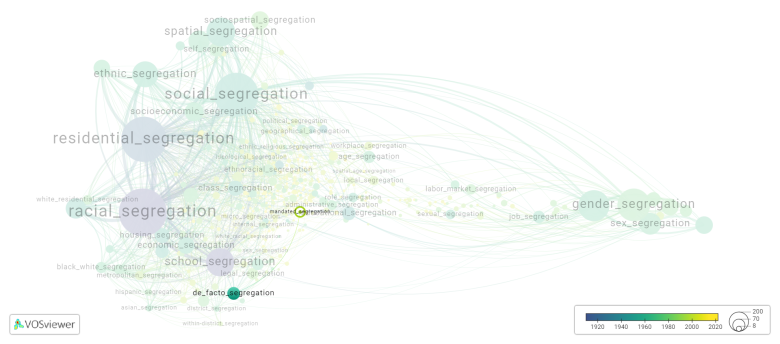Mandated segregation: Difference between revisions
(Creating page) |
(Creating page) |
||
| Line 20: | Line 20: | ||
de facto segregation | de facto segregation | ||
[[mandated_segregation.png|780x780px]] | [[File:mandated_segregation.png|780x780px]] | ||
For the complete network of associated segregation forms, see: | For the complete network of associated segregation forms, see: | ||
clusters https://tinyurl.com/2d8wg5n3 | clusters https://tinyurl.com/2d8wg5n3 | ||
Revision as of 16:34, 25 September 2024
Date and country of first publication[1]
2006
United States
Definition
Mandated segregation refers to a policy or practice that requires the separation of different racial or ethnic groups in various aspects of life, such as education, housing, public facilities, and transportation. This system of segregation was enforced through laws and regulations, particularly in the United States, during the era of racial discrimination known as Jim Crow.
During this period, African Americans and other minority groups were subjected to widespread discriminatory practices and denied equal access to opportunities and resources. Mandated segregation aimed to maintain a social hierarchy based on race, with white individuals enjoying privileges and advantages over non-white individuals.
Examples of mandated segregation included separate schools for white and black students, separate waiting rooms in public transport stations, separate seating areas in restaurants and theaters, and the imposition of separate water fountains and restrooms. These practices were eventually challenged and dismantled by the Civil Rights Movement in the mid-20th century.
Synonyms
The following terms are synonymous with:
mandatory segregation.
References and literature addressing this segregation form under these synonymous terms can be found below.
See also
Related segregation forms
Mandated segregation is frequently discussed in the literature with the following segregation forms:
de facto segregation
 For the complete network of associated segregation forms, see:
clusters https://tinyurl.com/2d8wg5n3
year of publication https://tinyurl.com/2235lkhw
betweenness centrality https://tinyurl.com/223udk5r
disciplines where segregation forms first appeared https://tinyurl.com/244d8unz
For the complete network of associated segregation forms, see:
clusters https://tinyurl.com/2d8wg5n3
year of publication https://tinyurl.com/2235lkhw
betweenness centrality https://tinyurl.com/223udk5r
disciplines where segregation forms first appeared https://tinyurl.com/244d8unz
References
Notes
- ↑ Date and country of first publication as informed by the Scopus database (December 2023).
At its current state, this definition has been generated by a Large Language Model (LLM) so far without review by an independent researcher or a member of the curating team of segregation experts that keep the Segregation Wiki online. While we strive for accuracy, we cannot guarantee its reliability, completeness and timeliness. Please use this content with caution and verify information as needed. Also, feel free to improve on the definition as you see fit, including the use of references and other informational resources. We value your input in enhancing the quality and accuracy of the definitions of segregation forms collectively offered in the Segregation Wiki ©.
Mandated segregation appears in the following literature
Brown K. (2006). "new" educational injustices in the "new" South Africa: A call for justice in the form of vertical equity. Journal of Educational Administration, 44(5), 509-519. https://doi.org/10.1108/09578230610683787
Chai C.-L. (2009). The Sungei Buloh Leper settlement: Illness and the technology of acquiescence. Asian Journal of Social Science, 37(3), 463-479+323. Brill Academic Publishers.https://doi.org/10.1163/156853109X436838
Cottrol R.J. (2013). The long, lingering shadow: Slavery, race, and law in the American hemisphere. The Long, Lingering Shadow: Slavery, Race, and Law in the American Hemisphere, 9780820344768(), 1-370. University of Georgia Press.https://doi.org/
Fofana M.O. (2013). The spectre of race in American medicine. Medical Humanities, 39(2), 137-141. BMJ Publishing Group.https://doi.org/10.1136/medhum-2013-010374
Ura J.D. (2014). The placement of conflict: The Supreme Court and issue attention in the national media. Covering the United States Supreme Court in the Digital Age, 153-172. Cambridge University Press.https://doi.org/10.1017/CBO9781107280595.009
Spain D. (2016). Constructive feminism: Women’s spaces and women’s rights in the American city. Constructive Feminism: Women's Spaces and Women's Rights in the American City, 1-259. Cornell University Press.https://doi.org/
Alnutt B. (2018). Another victory for the forces of democracy: The 1949 New Jersey civil rights act. Pennsylvania History, 85(3), 362-393. Penn State University Press.https://doi.org/10.5325/pennhistory.85.3.0362
